Business Communication Report: Negotiation, Presentations, and Systems
VerifiedAdded on 2020/07/23
|10
|3101
|97
Report
AI Summary
This report provides a comprehensive overview of business communication, encompassing key areas such as negotiation, presentations, bespoke business documents, and information systems. It begins by explaining the significance of negotiation in a business context, detailing different approaches and tactics. The report then delves into the development and delivery of presentations, covering various types, resource utilization, presentation methods, and best practices. Furthermore, it explores the creation of bespoke business documents, outlining characteristics, factors to consider, legal requirements, and techniques. Finally, the report examines information systems in a business environment, discussing their development stages, benefits, limitations, and associated legal, security, and confidentiality requirements, concluding with how to monitor their use and effectiveness. The report aims to enhance understanding and practical application of effective business communication strategies.
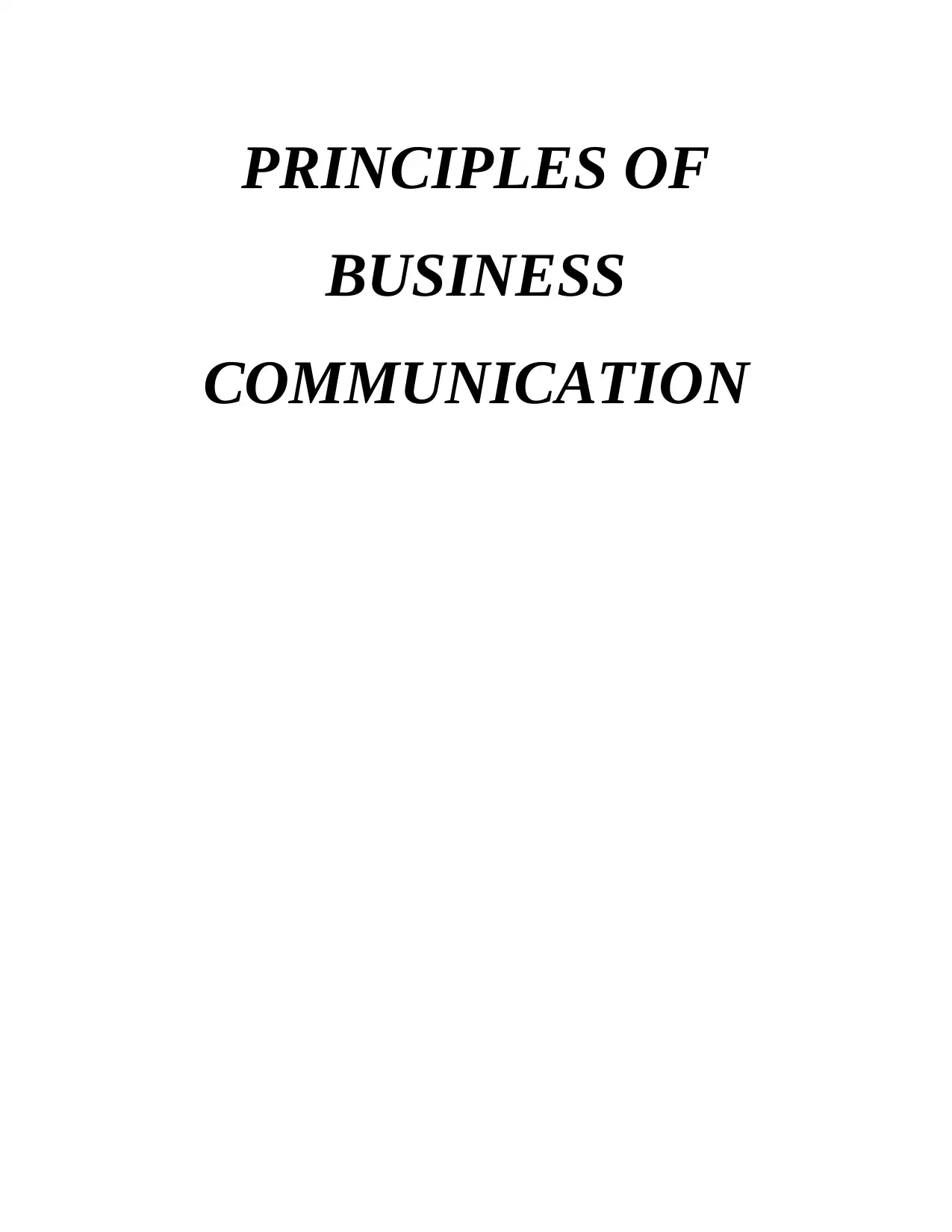
PRINCIPLES OF
BUSINESS
COMMUNICATION
BUSINESS
COMMUNICATION
Paraphrase This Document
Need a fresh take? Get an instant paraphrase of this document with our AI Paraphraser
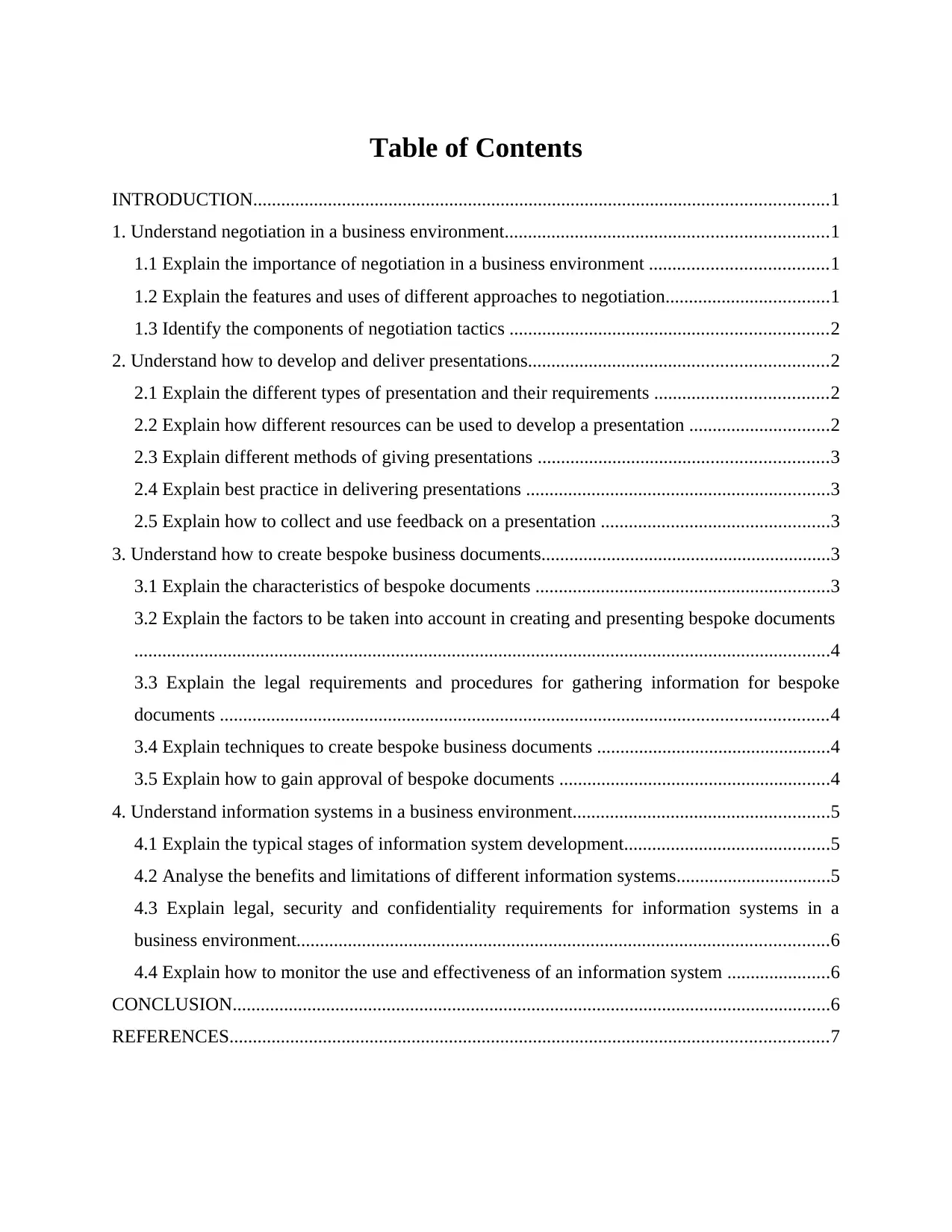
Table of Contents
INTRODUCTION...........................................................................................................................1
1. Understand negotiation in a business environment.....................................................................1
1.1 Explain the importance of negotiation in a business environment ......................................1
1.2 Explain the features and uses of different approaches to negotiation...................................1
1.3 Identify the components of negotiation tactics ....................................................................2
2. Understand how to develop and deliver presentations................................................................2
2.1 Explain the different types of presentation and their requirements .....................................2
2.2 Explain how different resources can be used to develop a presentation ..............................2
2.3 Explain different methods of giving presentations ..............................................................3
2.4 Explain best practice in delivering presentations .................................................................3
2.5 Explain how to collect and use feedback on a presentation .................................................3
3. Understand how to create bespoke business documents..............................................................3
3.1 Explain the characteristics of bespoke documents ...............................................................3
3.2 Explain the factors to be taken into account in creating and presenting bespoke documents
.....................................................................................................................................................4
3.3 Explain the legal requirements and procedures for gathering information for bespoke
documents ..................................................................................................................................4
3.4 Explain techniques to create bespoke business documents ..................................................4
3.5 Explain how to gain approval of bespoke documents ..........................................................4
4. Understand information systems in a business environment.......................................................5
4.1 Explain the typical stages of information system development............................................5
4.2 Analyse the benefits and limitations of different information systems.................................5
4.3 Explain legal, security and confidentiality requirements for information systems in a
business environment..................................................................................................................6
4.4 Explain how to monitor the use and effectiveness of an information system ......................6
CONCLUSION................................................................................................................................6
REFERENCES................................................................................................................................7
INTRODUCTION...........................................................................................................................1
1. Understand negotiation in a business environment.....................................................................1
1.1 Explain the importance of negotiation in a business environment ......................................1
1.2 Explain the features and uses of different approaches to negotiation...................................1
1.3 Identify the components of negotiation tactics ....................................................................2
2. Understand how to develop and deliver presentations................................................................2
2.1 Explain the different types of presentation and their requirements .....................................2
2.2 Explain how different resources can be used to develop a presentation ..............................2
2.3 Explain different methods of giving presentations ..............................................................3
2.4 Explain best practice in delivering presentations .................................................................3
2.5 Explain how to collect and use feedback on a presentation .................................................3
3. Understand how to create bespoke business documents..............................................................3
3.1 Explain the characteristics of bespoke documents ...............................................................3
3.2 Explain the factors to be taken into account in creating and presenting bespoke documents
.....................................................................................................................................................4
3.3 Explain the legal requirements and procedures for gathering information for bespoke
documents ..................................................................................................................................4
3.4 Explain techniques to create bespoke business documents ..................................................4
3.5 Explain how to gain approval of bespoke documents ..........................................................4
4. Understand information systems in a business environment.......................................................5
4.1 Explain the typical stages of information system development............................................5
4.2 Analyse the benefits and limitations of different information systems.................................5
4.3 Explain legal, security and confidentiality requirements for information systems in a
business environment..................................................................................................................6
4.4 Explain how to monitor the use and effectiveness of an information system ......................6
CONCLUSION................................................................................................................................6
REFERENCES................................................................................................................................7
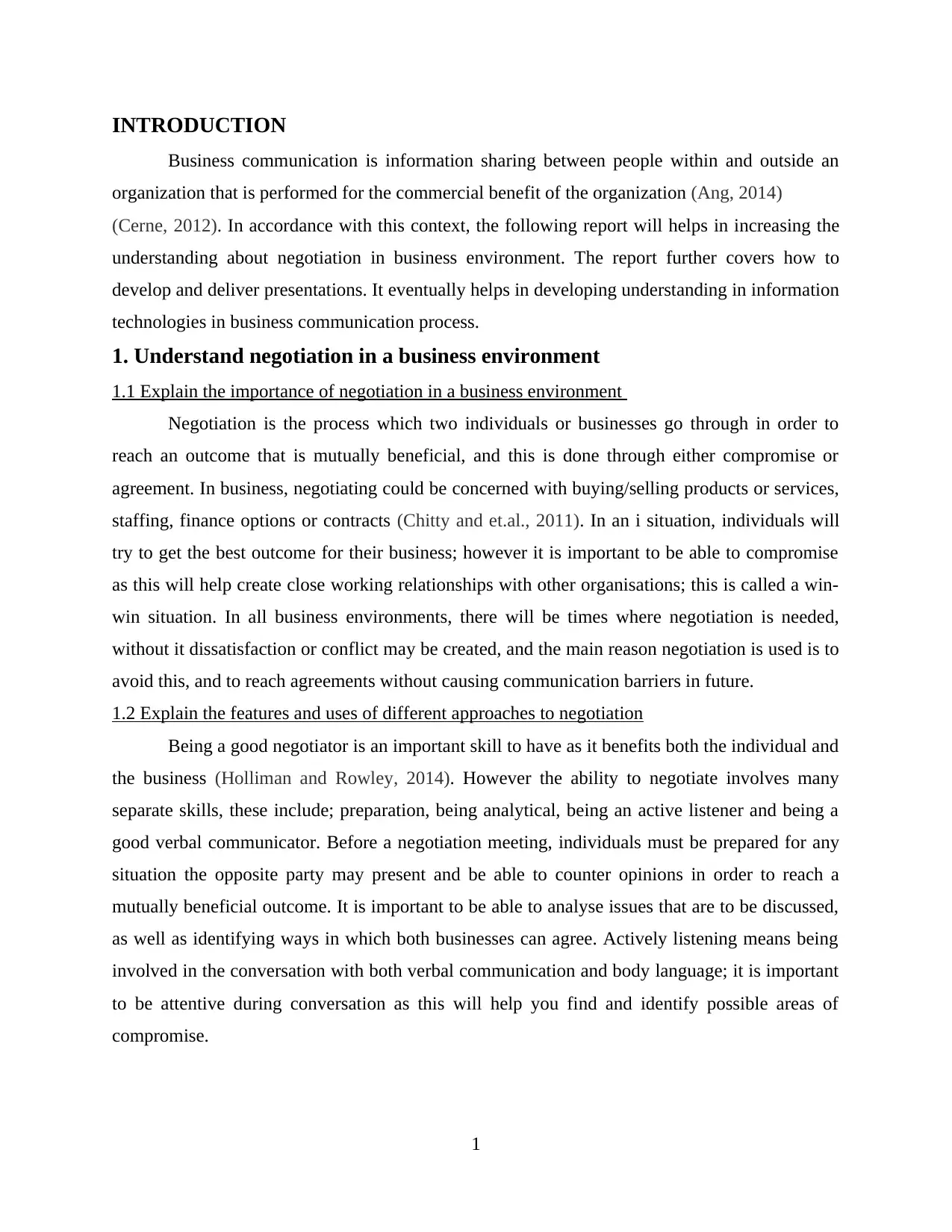
INTRODUCTION
Business communication is information sharing between people within and outside an
organization that is performed for the commercial benefit of the organization (Ang, 2014)
(Cerne, 2012). In accordance with this context, the following report will helps in increasing the
understanding about negotiation in business environment. The report further covers how to
develop and deliver presentations. It eventually helps in developing understanding in information
technologies in business communication process.
1. Understand negotiation in a business environment
1.1 Explain the importance of negotiation in a business environment
Negotiation is the process which two individuals or businesses go through in order to
reach an outcome that is mutually beneficial, and this is done through either compromise or
agreement. In business, negotiating could be concerned with buying/selling products or services,
staffing, finance options or contracts (Chitty and et.al., 2011). In an i situation, individuals will
try to get the best outcome for their business; however it is important to be able to compromise
as this will help create close working relationships with other organisations; this is called a win-
win situation. In all business environments, there will be times where negotiation is needed,
without it dissatisfaction or conflict may be created, and the main reason negotiation is used is to
avoid this, and to reach agreements without causing communication barriers in future.
1.2 Explain the features and uses of different approaches to negotiation
Being a good negotiator is an important skill to have as it benefits both the individual and
the business (Holliman and Rowley, 2014). However the ability to negotiate involves many
separate skills, these include; preparation, being analytical, being an active listener and being a
good verbal communicator. Before a negotiation meeting, individuals must be prepared for any
situation the opposite party may present and be able to counter opinions in order to reach a
mutually beneficial outcome. It is important to be able to analyse issues that are to be discussed,
as well as identifying ways in which both businesses can agree. Actively listening means being
involved in the conversation with both verbal communication and body language; it is important
to be attentive during conversation as this will help you find and identify possible areas of
compromise.
1
Business communication is information sharing between people within and outside an
organization that is performed for the commercial benefit of the organization (Ang, 2014)
(Cerne, 2012). In accordance with this context, the following report will helps in increasing the
understanding about negotiation in business environment. The report further covers how to
develop and deliver presentations. It eventually helps in developing understanding in information
technologies in business communication process.
1. Understand negotiation in a business environment
1.1 Explain the importance of negotiation in a business environment
Negotiation is the process which two individuals or businesses go through in order to
reach an outcome that is mutually beneficial, and this is done through either compromise or
agreement. In business, negotiating could be concerned with buying/selling products or services,
staffing, finance options or contracts (Chitty and et.al., 2011). In an i situation, individuals will
try to get the best outcome for their business; however it is important to be able to compromise
as this will help create close working relationships with other organisations; this is called a win-
win situation. In all business environments, there will be times where negotiation is needed,
without it dissatisfaction or conflict may be created, and the main reason negotiation is used is to
avoid this, and to reach agreements without causing communication barriers in future.
1.2 Explain the features and uses of different approaches to negotiation
Being a good negotiator is an important skill to have as it benefits both the individual and
the business (Holliman and Rowley, 2014). However the ability to negotiate involves many
separate skills, these include; preparation, being analytical, being an active listener and being a
good verbal communicator. Before a negotiation meeting, individuals must be prepared for any
situation the opposite party may present and be able to counter opinions in order to reach a
mutually beneficial outcome. It is important to be able to analyse issues that are to be discussed,
as well as identifying ways in which both businesses can agree. Actively listening means being
involved in the conversation with both verbal communication and body language; it is important
to be attentive during conversation as this will help you find and identify possible areas of
compromise.
1
⊘ This is a preview!⊘
Do you want full access?
Subscribe today to unlock all pages.

Trusted by 1+ million students worldwide
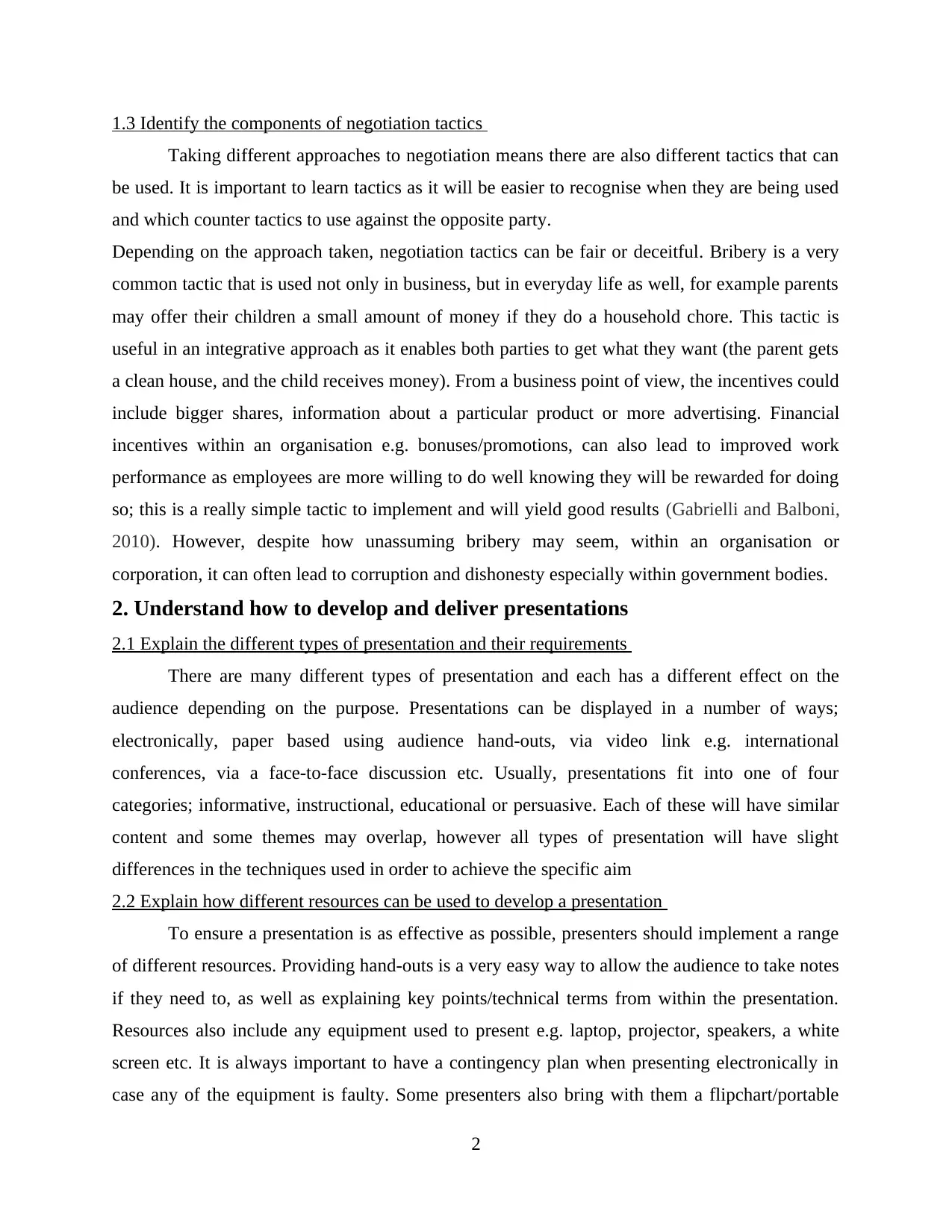
1.3 Identify the components of negotiation tactics
Taking different approaches to negotiation means there are also different tactics that can
be used. It is important to learn tactics as it will be easier to recognise when they are being used
and which counter tactics to use against the opposite party.
Depending on the approach taken, negotiation tactics can be fair or deceitful. Bribery is a very
common tactic that is used not only in business, but in everyday life as well, for example parents
may offer their children a small amount of money if they do a household chore. This tactic is
useful in an integrative approach as it enables both parties to get what they want (the parent gets
a clean house, and the child receives money). From a business point of view, the incentives could
include bigger shares, information about a particular product or more advertising. Financial
incentives within an organisation e.g. bonuses/promotions, can also lead to improved work
performance as employees are more willing to do well knowing they will be rewarded for doing
so; this is a really simple tactic to implement and will yield good results (Gabrielli and Balboni,
2010). However, despite how unassuming bribery may seem, within an organisation or
corporation, it can often lead to corruption and dishonesty especially within government bodies.
2. Understand how to develop and deliver presentations
2.1 Explain the different types of presentation and their requirements
There are many different types of presentation and each has a different effect on the
audience depending on the purpose. Presentations can be displayed in a number of ways;
electronically, paper based using audience hand-outs, via video link e.g. international
conferences, via a face-to-face discussion etc. Usually, presentations fit into one of four
categories; informative, instructional, educational or persuasive. Each of these will have similar
content and some themes may overlap, however all types of presentation will have slight
differences in the techniques used in order to achieve the specific aim
2.2 Explain how different resources can be used to develop a presentation
To ensure a presentation is as effective as possible, presenters should implement a range
of different resources. Providing hand-outs is a very easy way to allow the audience to take notes
if they need to, as well as explaining key points/technical terms from within the presentation.
Resources also include any equipment used to present e.g. laptop, projector, speakers, a white
screen etc. It is always important to have a contingency plan when presenting electronically in
case any of the equipment is faulty. Some presenters also bring with them a flipchart/portable
2
Taking different approaches to negotiation means there are also different tactics that can
be used. It is important to learn tactics as it will be easier to recognise when they are being used
and which counter tactics to use against the opposite party.
Depending on the approach taken, negotiation tactics can be fair or deceitful. Bribery is a very
common tactic that is used not only in business, but in everyday life as well, for example parents
may offer their children a small amount of money if they do a household chore. This tactic is
useful in an integrative approach as it enables both parties to get what they want (the parent gets
a clean house, and the child receives money). From a business point of view, the incentives could
include bigger shares, information about a particular product or more advertising. Financial
incentives within an organisation e.g. bonuses/promotions, can also lead to improved work
performance as employees are more willing to do well knowing they will be rewarded for doing
so; this is a really simple tactic to implement and will yield good results (Gabrielli and Balboni,
2010). However, despite how unassuming bribery may seem, within an organisation or
corporation, it can often lead to corruption and dishonesty especially within government bodies.
2. Understand how to develop and deliver presentations
2.1 Explain the different types of presentation and their requirements
There are many different types of presentation and each has a different effect on the
audience depending on the purpose. Presentations can be displayed in a number of ways;
electronically, paper based using audience hand-outs, via video link e.g. international
conferences, via a face-to-face discussion etc. Usually, presentations fit into one of four
categories; informative, instructional, educational or persuasive. Each of these will have similar
content and some themes may overlap, however all types of presentation will have slight
differences in the techniques used in order to achieve the specific aim
2.2 Explain how different resources can be used to develop a presentation
To ensure a presentation is as effective as possible, presenters should implement a range
of different resources. Providing hand-outs is a very easy way to allow the audience to take notes
if they need to, as well as explaining key points/technical terms from within the presentation.
Resources also include any equipment used to present e.g. laptop, projector, speakers, a white
screen etc. It is always important to have a contingency plan when presenting electronically in
case any of the equipment is faulty. Some presenters also bring with them a flipchart/portable
2
Paraphrase This Document
Need a fresh take? Get an instant paraphrase of this document with our AI Paraphraser
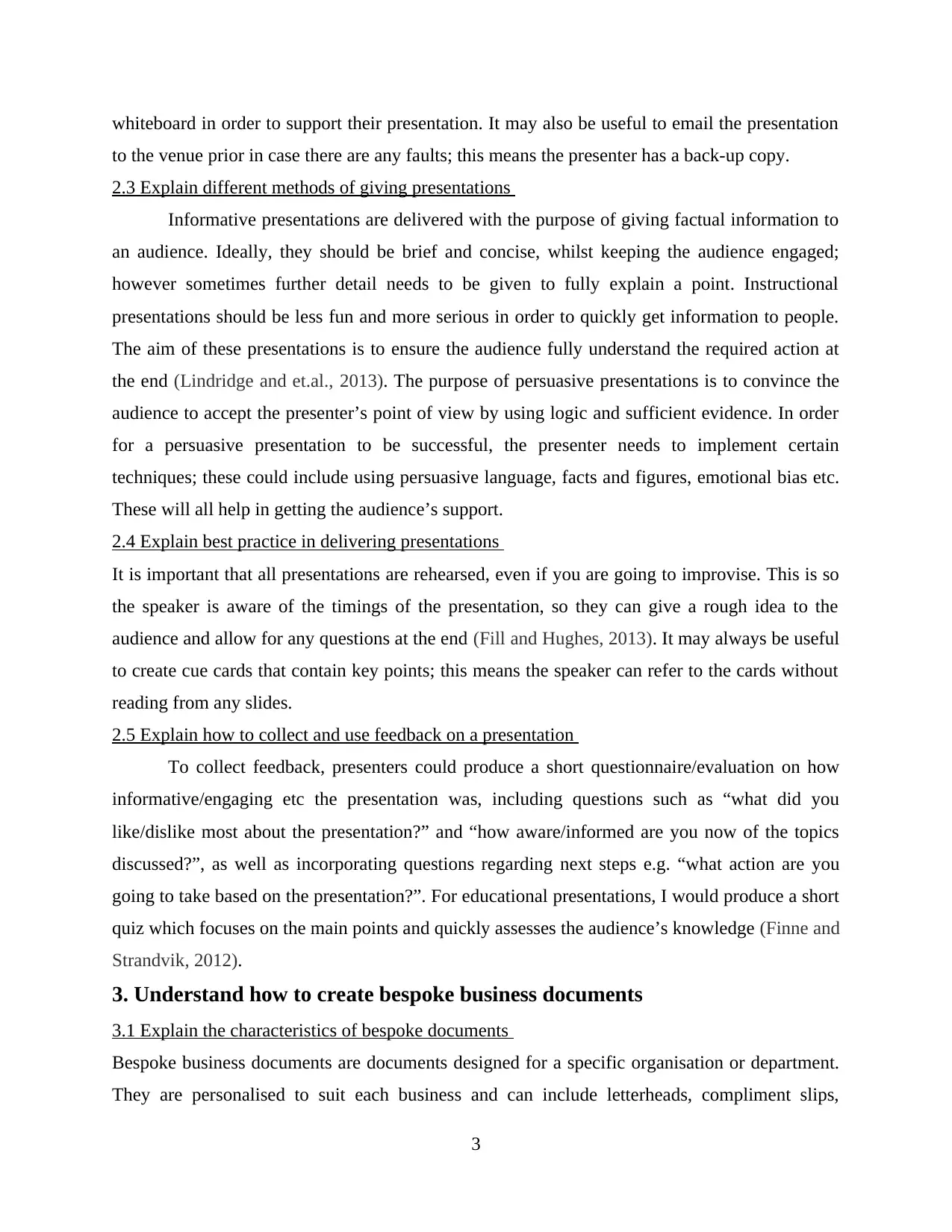
whiteboard in order to support their presentation. It may also be useful to email the presentation
to the venue prior in case there are any faults; this means the presenter has a back-up copy.
2.3 Explain different methods of giving presentations
Informative presentations are delivered with the purpose of giving factual information to
an audience. Ideally, they should be brief and concise, whilst keeping the audience engaged;
however sometimes further detail needs to be given to fully explain a point. Instructional
presentations should be less fun and more serious in order to quickly get information to people.
The aim of these presentations is to ensure the audience fully understand the required action at
the end (Lindridge and et.al., 2013). The purpose of persuasive presentations is to convince the
audience to accept the presenter’s point of view by using logic and sufficient evidence. In order
for a persuasive presentation to be successful, the presenter needs to implement certain
techniques; these could include using persuasive language, facts and figures, emotional bias etc.
These will all help in getting the audience’s support.
2.4 Explain best practice in delivering presentations
It is important that all presentations are rehearsed, even if you are going to improvise. This is so
the speaker is aware of the timings of the presentation, so they can give a rough idea to the
audience and allow for any questions at the end (Fill and Hughes, 2013). It may always be useful
to create cue cards that contain key points; this means the speaker can refer to the cards without
reading from any slides.
2.5 Explain how to collect and use feedback on a presentation
To collect feedback, presenters could produce a short questionnaire/evaluation on how
informative/engaging etc the presentation was, including questions such as “what did you
like/dislike most about the presentation?” and “how aware/informed are you now of the topics
discussed?”, as well as incorporating questions regarding next steps e.g. “what action are you
going to take based on the presentation?”. For educational presentations, I would produce a short
quiz which focuses on the main points and quickly assesses the audience’s knowledge (Finne and
Strandvik, 2012).
3. Understand how to create bespoke business documents
3.1 Explain the characteristics of bespoke documents
Bespoke business documents are documents designed for a specific organisation or department.
They are personalised to suit each business and can include letterheads, compliment slips,
3
to the venue prior in case there are any faults; this means the presenter has a back-up copy.
2.3 Explain different methods of giving presentations
Informative presentations are delivered with the purpose of giving factual information to
an audience. Ideally, they should be brief and concise, whilst keeping the audience engaged;
however sometimes further detail needs to be given to fully explain a point. Instructional
presentations should be less fun and more serious in order to quickly get information to people.
The aim of these presentations is to ensure the audience fully understand the required action at
the end (Lindridge and et.al., 2013). The purpose of persuasive presentations is to convince the
audience to accept the presenter’s point of view by using logic and sufficient evidence. In order
for a persuasive presentation to be successful, the presenter needs to implement certain
techniques; these could include using persuasive language, facts and figures, emotional bias etc.
These will all help in getting the audience’s support.
2.4 Explain best practice in delivering presentations
It is important that all presentations are rehearsed, even if you are going to improvise. This is so
the speaker is aware of the timings of the presentation, so they can give a rough idea to the
audience and allow for any questions at the end (Fill and Hughes, 2013). It may always be useful
to create cue cards that contain key points; this means the speaker can refer to the cards without
reading from any slides.
2.5 Explain how to collect and use feedback on a presentation
To collect feedback, presenters could produce a short questionnaire/evaluation on how
informative/engaging etc the presentation was, including questions such as “what did you
like/dislike most about the presentation?” and “how aware/informed are you now of the topics
discussed?”, as well as incorporating questions regarding next steps e.g. “what action are you
going to take based on the presentation?”. For educational presentations, I would produce a short
quiz which focuses on the main points and quickly assesses the audience’s knowledge (Finne and
Strandvik, 2012).
3. Understand how to create bespoke business documents
3.1 Explain the characteristics of bespoke documents
Bespoke business documents are documents designed for a specific organisation or department.
They are personalised to suit each business and can include letterheads, compliment slips,
3
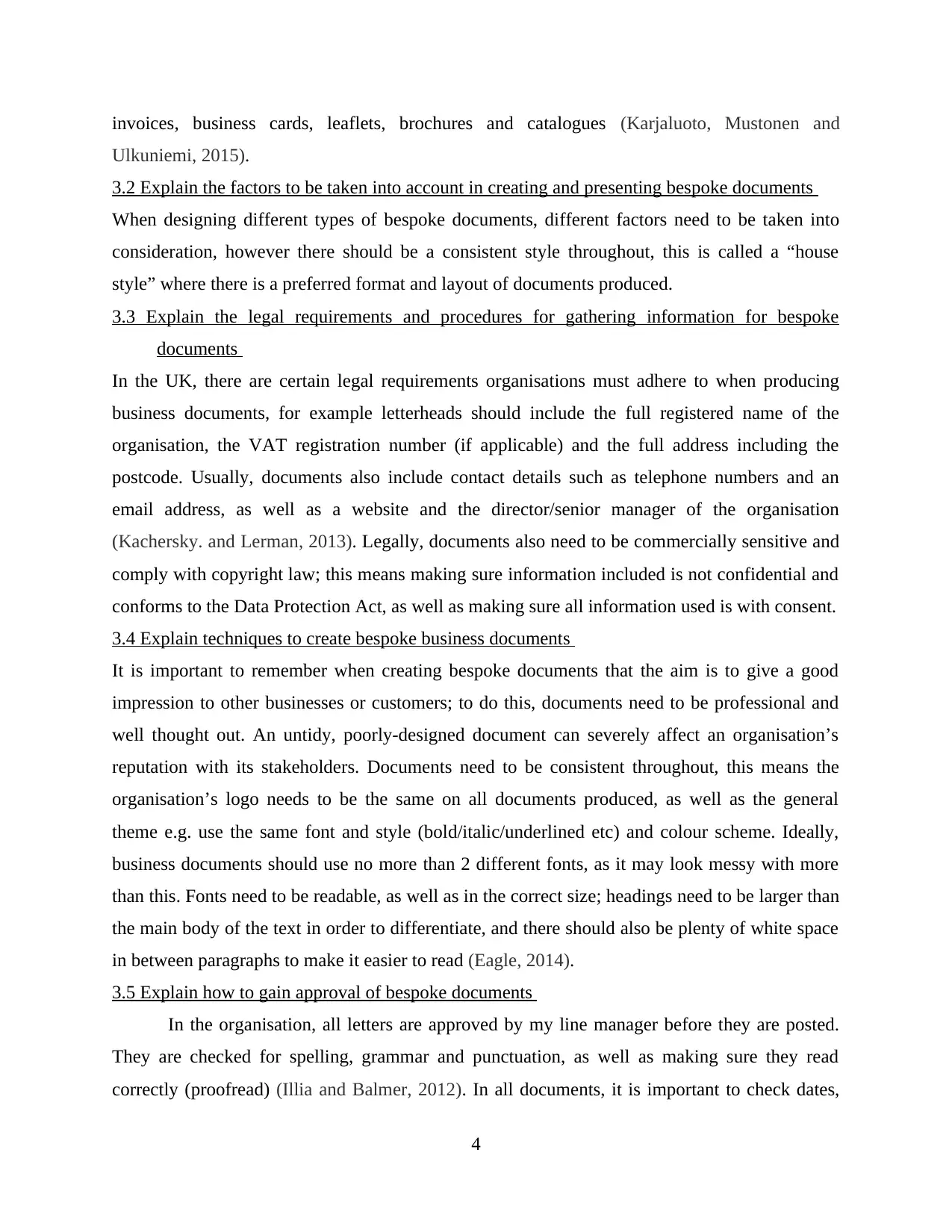
invoices, business cards, leaflets, brochures and catalogues (Karjaluoto, Mustonen and
Ulkuniemi, 2015).
3.2 Explain the factors to be taken into account in creating and presenting bespoke documents
When designing different types of bespoke documents, different factors need to be taken into
consideration, however there should be a consistent style throughout, this is called a “house
style” where there is a preferred format and layout of documents produced.
3.3 Explain the legal requirements and procedures for gathering information for bespoke
documents
In the UK, there are certain legal requirements organisations must adhere to when producing
business documents, for example letterheads should include the full registered name of the
organisation, the VAT registration number (if applicable) and the full address including the
postcode. Usually, documents also include contact details such as telephone numbers and an
email address, as well as a website and the director/senior manager of the organisation
(Kachersky. and Lerman, 2013). Legally, documents also need to be commercially sensitive and
comply with copyright law; this means making sure information included is not confidential and
conforms to the Data Protection Act, as well as making sure all information used is with consent.
3.4 Explain techniques to create bespoke business documents
It is important to remember when creating bespoke documents that the aim is to give a good
impression to other businesses or customers; to do this, documents need to be professional and
well thought out. An untidy, poorly-designed document can severely affect an organisation’s
reputation with its stakeholders. Documents need to be consistent throughout, this means the
organisation’s logo needs to be the same on all documents produced, as well as the general
theme e.g. use the same font and style (bold/italic/underlined etc) and colour scheme. Ideally,
business documents should use no more than 2 different fonts, as it may look messy with more
than this. Fonts need to be readable, as well as in the correct size; headings need to be larger than
the main body of the text in order to differentiate, and there should also be plenty of white space
in between paragraphs to make it easier to read (Eagle, 2014).
3.5 Explain how to gain approval of bespoke documents
In the organisation, all letters are approved by my line manager before they are posted.
They are checked for spelling, grammar and punctuation, as well as making sure they read
correctly (proofread) (Illia and Balmer, 2012). In all documents, it is important to check dates,
4
Ulkuniemi, 2015).
3.2 Explain the factors to be taken into account in creating and presenting bespoke documents
When designing different types of bespoke documents, different factors need to be taken into
consideration, however there should be a consistent style throughout, this is called a “house
style” where there is a preferred format and layout of documents produced.
3.3 Explain the legal requirements and procedures for gathering information for bespoke
documents
In the UK, there are certain legal requirements organisations must adhere to when producing
business documents, for example letterheads should include the full registered name of the
organisation, the VAT registration number (if applicable) and the full address including the
postcode. Usually, documents also include contact details such as telephone numbers and an
email address, as well as a website and the director/senior manager of the organisation
(Kachersky. and Lerman, 2013). Legally, documents also need to be commercially sensitive and
comply with copyright law; this means making sure information included is not confidential and
conforms to the Data Protection Act, as well as making sure all information used is with consent.
3.4 Explain techniques to create bespoke business documents
It is important to remember when creating bespoke documents that the aim is to give a good
impression to other businesses or customers; to do this, documents need to be professional and
well thought out. An untidy, poorly-designed document can severely affect an organisation’s
reputation with its stakeholders. Documents need to be consistent throughout, this means the
organisation’s logo needs to be the same on all documents produced, as well as the general
theme e.g. use the same font and style (bold/italic/underlined etc) and colour scheme. Ideally,
business documents should use no more than 2 different fonts, as it may look messy with more
than this. Fonts need to be readable, as well as in the correct size; headings need to be larger than
the main body of the text in order to differentiate, and there should also be plenty of white space
in between paragraphs to make it easier to read (Eagle, 2014).
3.5 Explain how to gain approval of bespoke documents
In the organisation, all letters are approved by my line manager before they are posted.
They are checked for spelling, grammar and punctuation, as well as making sure they read
correctly (proofread) (Illia and Balmer, 2012). In all documents, it is important to check dates,
4
⊘ This is a preview!⊘
Do you want full access?
Subscribe today to unlock all pages.

Trusted by 1+ million students worldwide
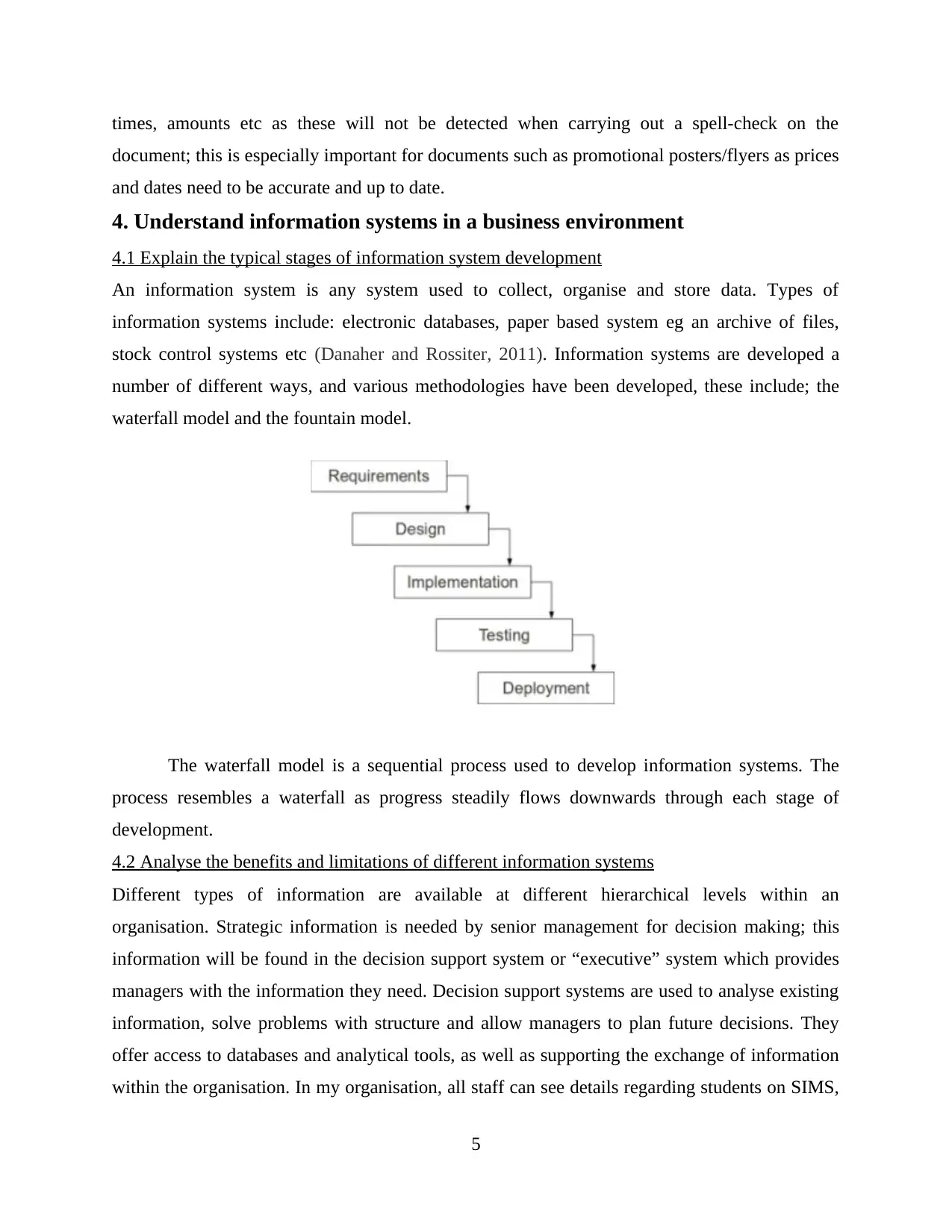
times, amounts etc as these will not be detected when carrying out a spell-check on the
document; this is especially important for documents such as promotional posters/flyers as prices
and dates need to be accurate and up to date.
4. Understand information systems in a business environment
4.1 Explain the typical stages of information system development
An information system is any system used to collect, organise and store data. Types of
information systems include: electronic databases, paper based system eg an archive of files,
stock control systems etc (Danaher and Rossiter, 2011). Information systems are developed a
number of different ways, and various methodologies have been developed, these include; the
waterfall model and the fountain model.
The waterfall model is a sequential process used to develop information systems. The
process resembles a waterfall as progress steadily flows downwards through each stage of
development.
4.2 Analyse the benefits and limitations of different information systems
Different types of information are available at different hierarchical levels within an
organisation. Strategic information is needed by senior management for decision making; this
information will be found in the decision support system or “executive” system which provides
managers with the information they need. Decision support systems are used to analyse existing
information, solve problems with structure and allow managers to plan future decisions. They
offer access to databases and analytical tools, as well as supporting the exchange of information
within the organisation. In my organisation, all staff can see details regarding students on SIMS,
5
document; this is especially important for documents such as promotional posters/flyers as prices
and dates need to be accurate and up to date.
4. Understand information systems in a business environment
4.1 Explain the typical stages of information system development
An information system is any system used to collect, organise and store data. Types of
information systems include: electronic databases, paper based system eg an archive of files,
stock control systems etc (Danaher and Rossiter, 2011). Information systems are developed a
number of different ways, and various methodologies have been developed, these include; the
waterfall model and the fountain model.
The waterfall model is a sequential process used to develop information systems. The
process resembles a waterfall as progress steadily flows downwards through each stage of
development.
4.2 Analyse the benefits and limitations of different information systems
Different types of information are available at different hierarchical levels within an
organisation. Strategic information is needed by senior management for decision making; this
information will be found in the decision support system or “executive” system which provides
managers with the information they need. Decision support systems are used to analyse existing
information, solve problems with structure and allow managers to plan future decisions. They
offer access to databases and analytical tools, as well as supporting the exchange of information
within the organisation. In my organisation, all staff can see details regarding students on SIMS,
5
Paraphrase This Document
Need a fresh take? Get an instant paraphrase of this document with our AI Paraphraser
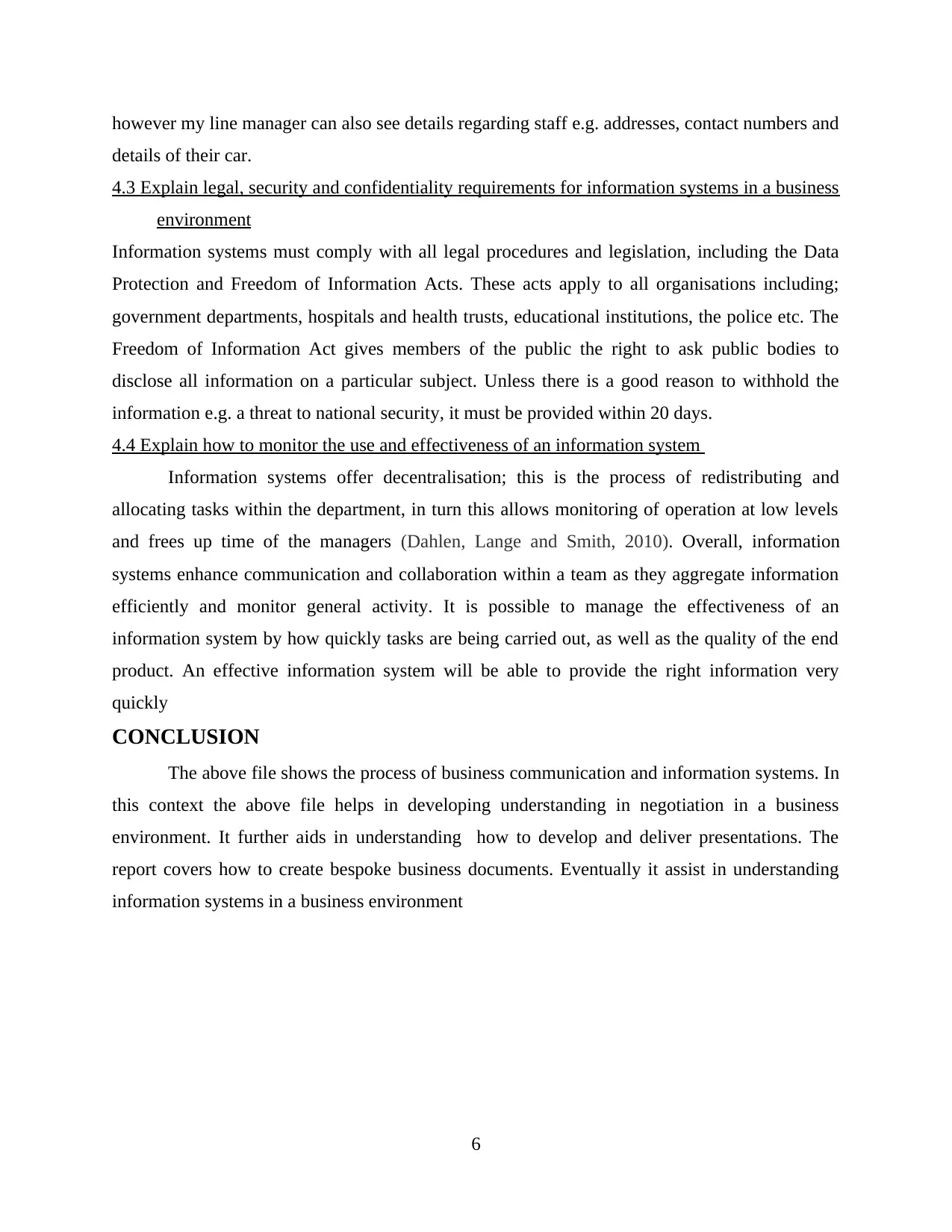
however my line manager can also see details regarding staff e.g. addresses, contact numbers and
details of their car.
4.3 Explain legal, security and confidentiality requirements for information systems in a business
environment
Information systems must comply with all legal procedures and legislation, including the Data
Protection and Freedom of Information Acts. These acts apply to all organisations including;
government departments, hospitals and health trusts, educational institutions, the police etc. The
Freedom of Information Act gives members of the public the right to ask public bodies to
disclose all information on a particular subject. Unless there is a good reason to withhold the
information e.g. a threat to national security, it must be provided within 20 days.
4.4 Explain how to monitor the use and effectiveness of an information system
Information systems offer decentralisation; this is the process of redistributing and
allocating tasks within the department, in turn this allows monitoring of operation at low levels
and frees up time of the managers (Dahlen, Lange and Smith, 2010). Overall, information
systems enhance communication and collaboration within a team as they aggregate information
efficiently and monitor general activity. It is possible to manage the effectiveness of an
information system by how quickly tasks are being carried out, as well as the quality of the end
product. An effective information system will be able to provide the right information very
quickly
CONCLUSION
The above file shows the process of business communication and information systems. In
this context the above file helps in developing understanding in negotiation in a business
environment. It further aids in understanding how to develop and deliver presentations. The
report covers how to create bespoke business documents. Eventually it assist in understanding
information systems in a business environment
6
details of their car.
4.3 Explain legal, security and confidentiality requirements for information systems in a business
environment
Information systems must comply with all legal procedures and legislation, including the Data
Protection and Freedom of Information Acts. These acts apply to all organisations including;
government departments, hospitals and health trusts, educational institutions, the police etc. The
Freedom of Information Act gives members of the public the right to ask public bodies to
disclose all information on a particular subject. Unless there is a good reason to withhold the
information e.g. a threat to national security, it must be provided within 20 days.
4.4 Explain how to monitor the use and effectiveness of an information system
Information systems offer decentralisation; this is the process of redistributing and
allocating tasks within the department, in turn this allows monitoring of operation at low levels
and frees up time of the managers (Dahlen, Lange and Smith, 2010). Overall, information
systems enhance communication and collaboration within a team as they aggregate information
efficiently and monitor general activity. It is possible to manage the effectiveness of an
information system by how quickly tasks are being carried out, as well as the quality of the end
product. An effective information system will be able to provide the right information very
quickly
CONCLUSION
The above file shows the process of business communication and information systems. In
this context the above file helps in developing understanding in negotiation in a business
environment. It further aids in understanding how to develop and deliver presentations. The
report covers how to create bespoke business documents. Eventually it assist in understanding
information systems in a business environment
6
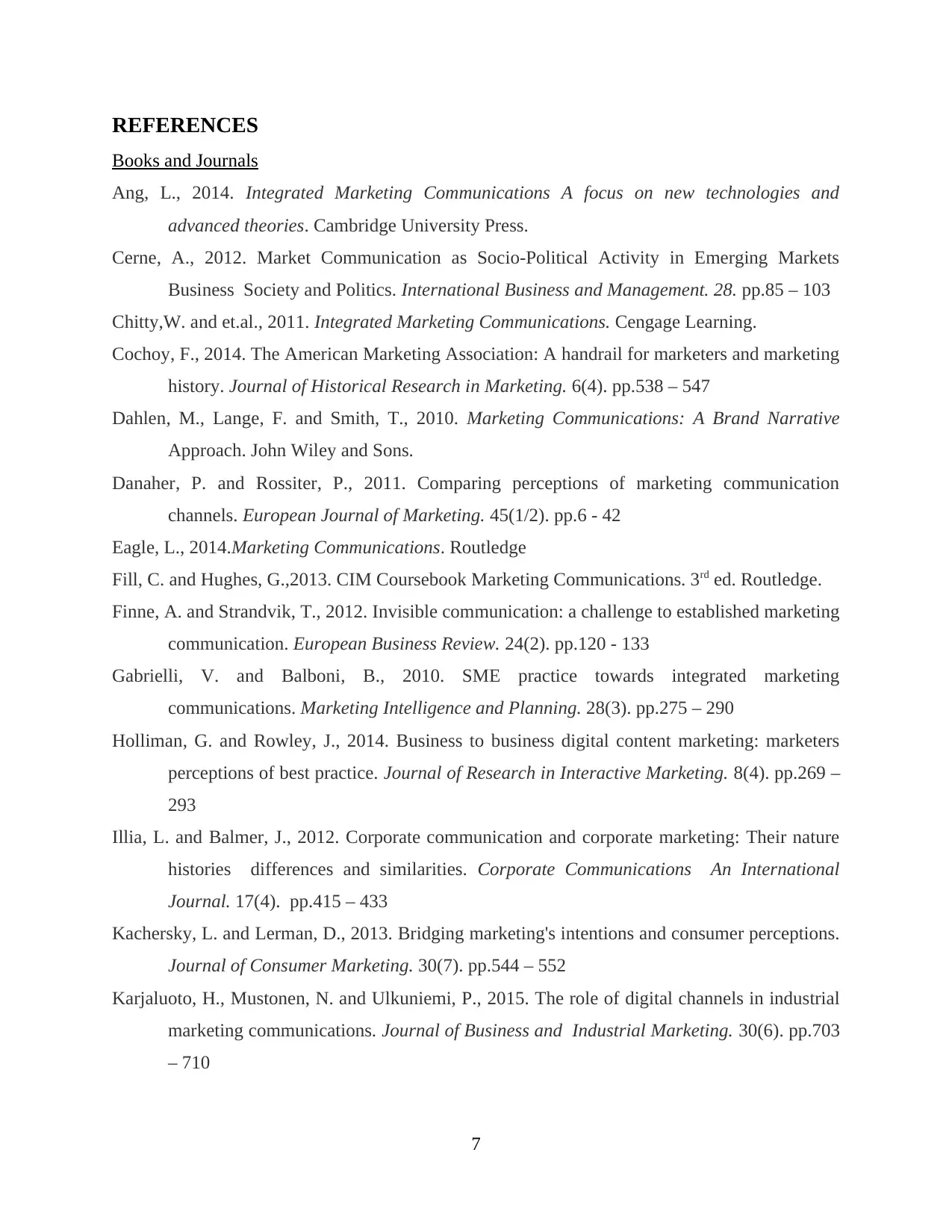
REFERENCES
Books and Journals
Ang, L., 2014. Integrated Marketing Communications A focus on new technologies and
advanced theories. Cambridge University Press.
Cerne, A., 2012. Market Communication as Socio-Political Activity in Emerging Markets
Business Society and Politics. International Business and Management. 28. pp.85 – 103
Chitty,W. and et.al., 2011. Integrated Marketing Communications. Cengage Learning.
Cochoy, F., 2014. The American Marketing Association: A handrail for marketers and marketing
history. Journal of Historical Research in Marketing. 6(4). pp.538 – 547
Dahlen, M., Lange, F. and Smith, T., 2010. Marketing Communications: A Brand Narrative
Approach. John Wiley and Sons.
Danaher, P. and Rossiter, P., 2011. Comparing perceptions of marketing communication
channels. European Journal of Marketing. 45(1/2). pp.6 - 42
Eagle, L., 2014.Marketing Communications. Routledge
Fill, C. and Hughes, G.,2013. CIM Coursebook Marketing Communications. 3rd ed. Routledge.
Finne, A. and Strandvik, T., 2012. Invisible communication: a challenge to established marketing
communication. European Business Review. 24(2). pp.120 - 133
Gabrielli, V. and Balboni, B., 2010. SME practice towards integrated marketing
communications. Marketing Intelligence and Planning. 28(3). pp.275 – 290
Holliman, G. and Rowley, J., 2014. Business to business digital content marketing: marketers
perceptions of best practice. Journal of Research in Interactive Marketing. 8(4). pp.269 –
293
Illia, L. and Balmer, J., 2012. Corporate communication and corporate marketing: Their nature
histories differences and similarities. Corporate Communications An International
Journal. 17(4). pp.415 – 433
Kachersky, L. and Lerman, D., 2013. Bridging marketing's intentions and consumer perceptions.
Journal of Consumer Marketing. 30(7). pp.544 – 552
Karjaluoto, H., Mustonen, N. and Ulkuniemi, P., 2015. The role of digital channels in industrial
marketing communications. Journal of Business and Industrial Marketing. 30(6). pp.703
– 710
7
Books and Journals
Ang, L., 2014. Integrated Marketing Communications A focus on new technologies and
advanced theories. Cambridge University Press.
Cerne, A., 2012. Market Communication as Socio-Political Activity in Emerging Markets
Business Society and Politics. International Business and Management. 28. pp.85 – 103
Chitty,W. and et.al., 2011. Integrated Marketing Communications. Cengage Learning.
Cochoy, F., 2014. The American Marketing Association: A handrail for marketers and marketing
history. Journal of Historical Research in Marketing. 6(4). pp.538 – 547
Dahlen, M., Lange, F. and Smith, T., 2010. Marketing Communications: A Brand Narrative
Approach. John Wiley and Sons.
Danaher, P. and Rossiter, P., 2011. Comparing perceptions of marketing communication
channels. European Journal of Marketing. 45(1/2). pp.6 - 42
Eagle, L., 2014.Marketing Communications. Routledge
Fill, C. and Hughes, G.,2013. CIM Coursebook Marketing Communications. 3rd ed. Routledge.
Finne, A. and Strandvik, T., 2012. Invisible communication: a challenge to established marketing
communication. European Business Review. 24(2). pp.120 - 133
Gabrielli, V. and Balboni, B., 2010. SME practice towards integrated marketing
communications. Marketing Intelligence and Planning. 28(3). pp.275 – 290
Holliman, G. and Rowley, J., 2014. Business to business digital content marketing: marketers
perceptions of best practice. Journal of Research in Interactive Marketing. 8(4). pp.269 –
293
Illia, L. and Balmer, J., 2012. Corporate communication and corporate marketing: Their nature
histories differences and similarities. Corporate Communications An International
Journal. 17(4). pp.415 – 433
Kachersky, L. and Lerman, D., 2013. Bridging marketing's intentions and consumer perceptions.
Journal of Consumer Marketing. 30(7). pp.544 – 552
Karjaluoto, H., Mustonen, N. and Ulkuniemi, P., 2015. The role of digital channels in industrial
marketing communications. Journal of Business and Industrial Marketing. 30(6). pp.703
– 710
7
⊘ This is a preview!⊘
Do you want full access?
Subscribe today to unlock all pages.

Trusted by 1+ million students worldwide
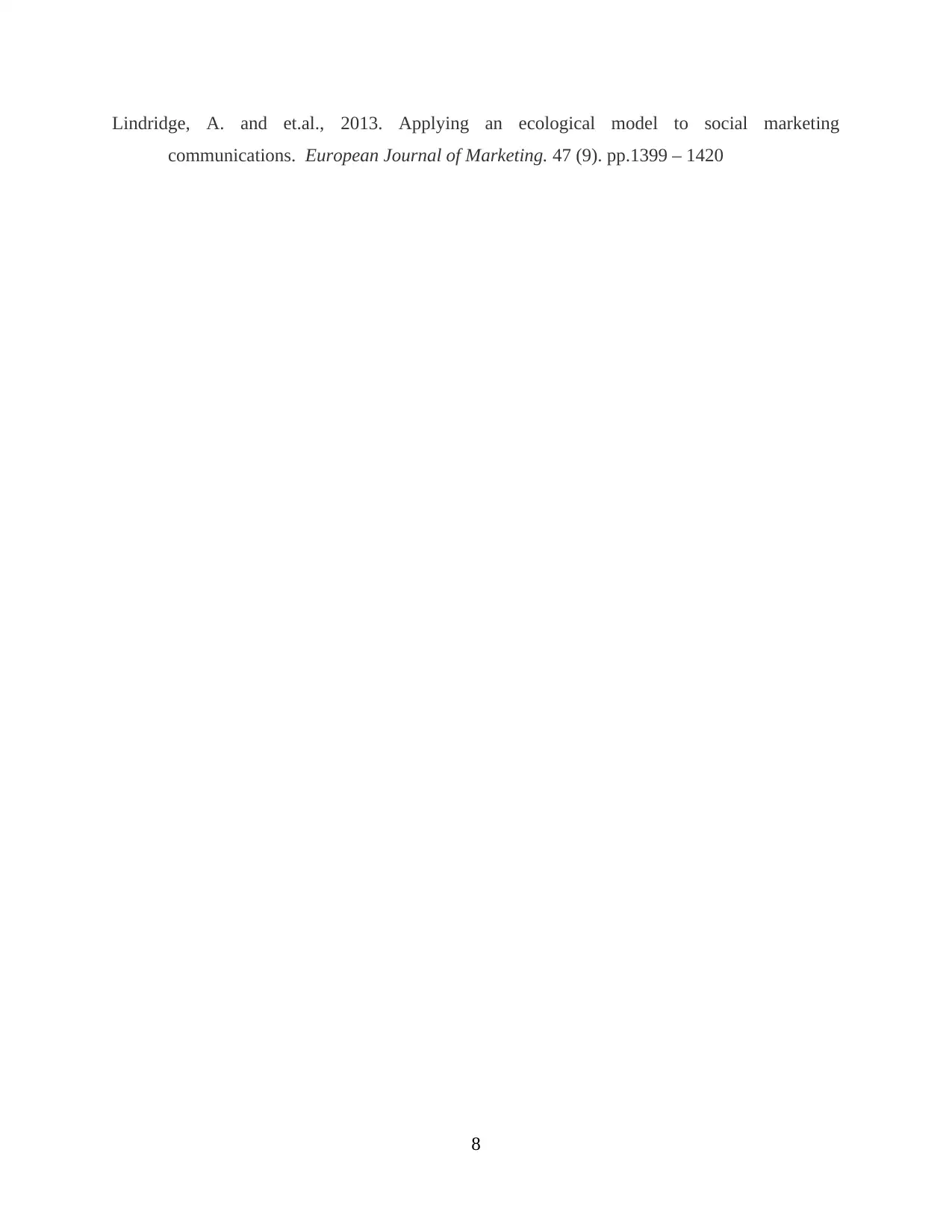
Lindridge, A. and et.al., 2013. Applying an ecological model to social marketing
communications. European Journal of Marketing. 47 (9). pp.1399 – 1420
8
communications. European Journal of Marketing. 47 (9). pp.1399 – 1420
8
1 out of 10
Related Documents
Your All-in-One AI-Powered Toolkit for Academic Success.
+13062052269
info@desklib.com
Available 24*7 on WhatsApp / Email
![[object Object]](/_next/static/media/star-bottom.7253800d.svg)
Unlock your academic potential
Copyright © 2020–2025 A2Z Services. All Rights Reserved. Developed and managed by ZUCOL.





